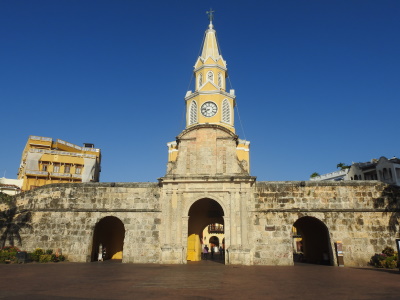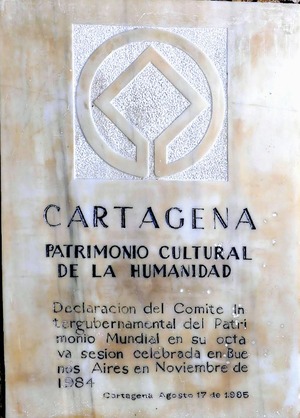Cartagena

The Port, Fortresses and Group of Monuments, Cartagena, comprise a port city and the remains of military constructions built by the Spanish.
Cartagena de Indias holds a strategic position at the commercial maritime routes in the Caribbean. From the 16th century on, the Spanish designed a defense plan to protect the city against the plundering of English, Dutch and French pirates. It led to one of the most extensive and complete systems of military fortifications in South America. Within the walled city, three neighbourhoods developed with fine civil, religious and residential monuments.
Community Perspective: the overall feel is much more Caribbean than South American, and one can easily spend 2 days here walking the city walls and exploring the historic center. But “it is so fully geared to tourism that sooner or later you will get fed up with it”.
Map of Cartagena
Community Reviews
Els Slots

A visit to Cartagena does leave you with mixed feelings. On the one hand, it is Colombia’s most vibrant city which also has preserved its historical core. On the other hand, it is so fully geared to tourism that sooner or later you will get fed up with it, trying to fend off the stream of sellers of water and hats and avoid the ubiquitous tour groups. I had about 2 full days there, which I found a good amount of time. When you walk away a bit from the clock tower area and the busiest parts of the historic center, it certainly gets enjoyable. The city also has an accessible and low-key airport with long-haul connections, for example to Amsterdam, New York and Lima.
The town’s OUV mostly is about its military fortresses and port. So on my first morning in the city I walked via the bridge from the center to the big fort on the other side of the bay. The Fort San Felipe de Barajas opens at 8 a.m. and I was one of the first visitors of the day, so it was very quiet. It is a fort built by the Spaniards in 1536, intended to expel the English from the Colombian coast.
Reportedly, it is the largest fort in South America. But only a small part dates from the 16th century, in the 17th and 18th centuries the structure was significantly enlarged to the large, bulky mass that it is now. There is a system of tunnels under the entire complex. In the former hospital, you can watch a 20-minute video explaining in detail how the Spaniards defeated the English fleet. It's already worth going in there for the strong air conditioning.
From the highest point of the fort, you have a good view of the city of Cartagena. What is striking is how many high-rise buildings there are - when I came flying in from Bogota it seemed as if we were landing in Dubai. The historic center within the city walls has also not escaped the more modern, higher buildings. They now often keep only the historic façades and build entirely new hotels and shopping centers behind them.
One of the best things to do in Cartagena is to walk the city walls. They still are about 70% intact and you can walk on them for most stretches. At sunset I walked the full loop, it is nice to see the city from different angles in this way. I for example discovered the former monastery La Merced and the theater next to it, two fine Italy-inspired buildings.
Another area worth exploring is Getsemani. This is the neighborhood, outside of the city walls but inside the WHS core zone, where the poor people of Cartagena used to live. Here also the uprising against the Spaniards and for independence began. For these people it has now become unaffordable - just about everything here has been converted into guest houses, restaurants, shops, and cafés. It is a nice area to stroll through though. Bits of Coral Masonry can still be seen in the walls. I visited it on a walking tour with a small group, but you can easily do it on your own.
There are a number of churches and museums as well in the historic center, but I found them overpriced. The entrance fees that you pay here in Cartagena are a lot higher than in the rest of the country. It generally costs 20,000 - 25,000 pesos per attraction (around 5-7 EUR). I entered 2 churches (the Cathedral and the Church of San Pedro Claver), but as in general in Colombia I found the interior of the churches to be not very rich. No comparison to Quito for example! I also visited 2 museums: the Inquisition building and the Maritime Museum. Both are located in beautiful historic buildings and for that, you actually have to go inside. There aren’t many original items among the exhibits however, most of it consists of information panels.
Read more from Els Slots here.
Ammon Watkins

After reading many travel reviews on Cartagena suggesting that less time is better (cost, crowds and hassle were frequently mentioned) we only gave ourselves one full day to see the old town. The highlights can certainly be seen in a busy day but I felt rushed and didn't do all that I'd hoped.
As a strategic Caribbean port for the colonial Spaniards, Cartagena was wealthy and needed protection. A lot of protection. Inscribed as the largest system of military fortifications in South America there are a lot of forts surrounding the bay/port and the wall surrounding the colonial core is still intact and good for strolling as well. We started with a visit to the massive Castillo de San Felipe, the largest and most important of the forts before venturing into the colonial core. Within, the centre is well preserved and densely packed with narrow streets and more traffic than it needs to have. Maybe it is obvious because of its location but the overall feel is much more Caribbean than South American. Think Havana, not Lima.
We were lucky and didn't have any cruise ships unloading hoards of tourists to overwhelm the centre but it still felt busy and there is no doubt this is the most visited city in Colombia. Trips into the bay or out to nearby islands should give a better perspective of the overall defensive strategy but we didn't have time. I was happy to have gotten a window seat on our flight out with an excellent birds-eye view of the bay to better appreciate how complicated its defense would be.
Cynthia Webb
The day we arrived in Cartagena (Nov. 2010) it was pouring rain. The streets were flooded, traffic was backed up and it was hard to get around. Nevertheless, it was nice to be there during the rainstorm because we saw a unique side of the city. When it rains, the water comes off of the fort in large, cascading waterfalls. Whether that was by design or merely water finding any open outlet, it created a unique and interesting view. The local children gathered under these waterfalls to play and bathe. The old town area wasn't flooded and we spent some time exploring that area, too. The rain also meant that not as many tourists were there and that there were fewer street vendors competing for our attention (although several enterprising ones were selling umbrellas).
Silrad
We visited Cartegena in the spring of 2009 and took a harbor cruise. We were able to see how the Spanish organized the 8 forts defensively to protect against pirate attacks. The view of the city's skyline in fantastic! We saw the spires of cathedrals outlined against a pristine, blue sky. We could see the building of modern skyscrapers being constructed. And, most impressively, the size of the bay. It is immense! No wonder Cartegena has been an important port for centuries.
Kelly Henry
Cartagena is a port city known for its giant fort. Think old town San Juan, Puerto Rico or Campeche, Mexico only bigger. The town is extremely well preserved and receives few tourists most likely because of Colombia's violent drug trafficking.
The clean and tidy town is dominated by a huge, well preserved stone fort that can be explored from top to bottom. The streets beneath the fort are a cobbled jumble of colorful two story homes and shops. An elevated promenade along the water (appears to be a built up sea wall) allows you to see all over the historic centre. Spanish colonial architecture influence is evident throughout the old part of the city.
Cartagena contains some beautifully preserved churches and convents in the hills above the town as well as the requisite spanish baroque style cathedral in the city centre.
Cartagena also has some areas that are not tourist friendly but it is generally safe. You need to speak at least a bit of spanish though for an enjoyable visit. Prices are dirt cheap!!
Community Rating
- : Van Hung Maxine Eisenberg Pieter Dijkshoorn Misio_pysio LuHa Rvieira Palka25
- : Szucs Tamas Keith90245 Christoph Priyaranjan Mohapatra Xtopher33
- : Xiquinho Silva Daniel Gabi Cobaltrage Michael anak Kenyalang Tevity Frédéric M Little Lauren Travels Alvaro1404 Cmtcosta Hanming Larry F Kelseyyurek J_neveryes Alejandro Lau Ssong.x
- : Joyce van Soest Tamara Ratz Alexander Lehmann Maciej Gil HaraldOest Lichia Santiago Lafuente Philipp Leu Alikander99 Oscar Wu
- : Els Slots João Aender Hubert Craig Harder KAO Dennis Nicklaus Ammon Watkins Don Irwin Dorejd Carlos Sotelo Shombob Adrian Turtschi John Linz
- : Solivagant Stanimir Hammeel Lucio Gorla GeorgeIng61 Jon Opol
- : Mikko Zoë Sheng
- : Chris Law
Site Info
- Full Name
- Port, Fortresses and Group of Monuments, Cartagena
- Unesco ID
- 285
- Country
- Colombia
- Inscribed
- 1984
- Type
- Cultural
- Criteria
-
4 6
- Categories
- Urban landscape - Colonial Urban landscape - Maritime
- Link
- By ID
Site History
1984 Inscribed
Site Links
Connections
The site has 32 connections
Art and Architecture
Constructions
Damaged
Geography
History
Human Activity
Individual People
Literature and Film
Religion and Belief
Timeline
Trivia
Visiting conditions
WHS Names
WHS on Other Lists
World Heritage Process
Visitors
236 Community Members have visited.
The Plaque
 (photo by Solivagant)
(photo by Solivagant)